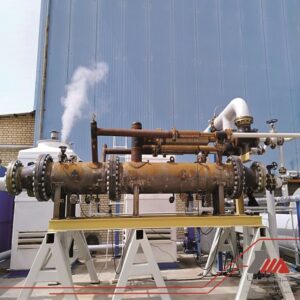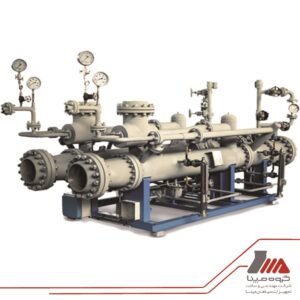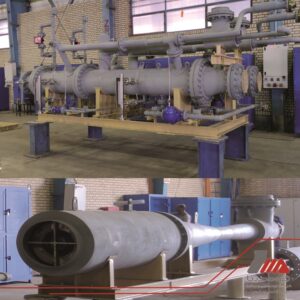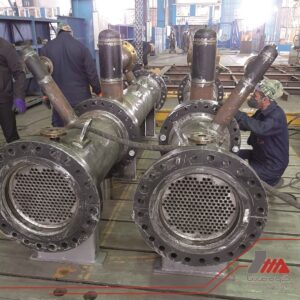Vacuum Supply System (Ejector)




- Introduction:
Thermal Vacuum Pump (Ejector)
Sepahan MAPNA Engineering & Equipment Manufacturing Company has started designing and manufacturing thermal vacuum pumps by relying on its own technical knowledge since 2011. Using technical knowledge and equipment inside the company, which includes vacuum testing facilities, Sepahan MAPNA is capable of designing and producing a wide range of ejectors with low energy consumption and high efficiency.
Unique product design, testing equipment in the factory, continuous research and development in increasing the efficiency of ejectors, and providing support services and repairs and maintenance of related products are some of the advantages of Sepahan MAPNA Engineering & Equipment Manufacturing Company relating to customer service in various industries.
- Introduction to Ejector:
Thermal vacuum pumps, simply called ejectors, are devices for transporting, compressing, or mixing gases, vapors, liquids, or solid particles. Ejectors are actually vacuum pumps that have no moving parts and a gaseous fluid or liquid acts as the driving force in them.
Advantages of this equipment include:
– Having no moving parts
– High operational reliability
– Low maintenance cost
– Ability to use a wide range of materials
The ejector acts by accelerating a high pressure using a nozzle and transforms static pressure into velocity pressure. The expansion of the high-pressure current by passing through an initial nozzle leads to an increase in the velocity and a decrease of pressure at the nozzle outlet. Creating a low-pressure area at the nozzle outlet leads to the suction of fluid from the ejector suction section. The two currents are then mixed, followed by a second shock which aims to achieve the desired pressure.
- Applications of the Ejector:
The ejector is being used in various industries, including:
- Petrochemical industries
- Oil and gas industries
- Power plant industry
- Water Desalination
- Steel Industries
- Paper production industries
- Pharmaceutical Industries
- Marine industries
- Water and wastewater
- Perfume making
- Shipbuilding industries
- Food industry (beverages – dairy products – oil production – canning)
- Vacuum System
The vacuum system is a combination of several steam ejectors and recovery condensers and is used to produce more vacuum. If a single-stage ejector is used to create a vacuum, there will be a significant increase in the amount of required pressure of the system. Therefore, the main application of a vacuum system is to create more vacuum for the driving fluid compared to a single-stage ejector for certain pressure and temperature.
- Introduction to power plant vacuum system
The main role of this system is to supply the condenser with the vacuum in the startup phase using a startup ejector (hogging) and maintain the vacuum at the time of operation using service ejectors (holding).
All the steam used in this system is condensed by the middle and end condenser, which are placed after the first and second stage ejectors, and then returns to the condensate tank. The energy resulting from the change of vapor phase to liquid will also increase the temperature of the water entering the boiler and thus enhancing the overall efficiency of the system.
- Ejectors Testing Platform
Sepahan MAPNA Engineering & Equipment Manufacturing Company is equipped with the required facilities for testing ejectors and vacuum systems; these facilities have been designed and produced according to the latest HEI standard inside the factory environment. Using these facilities, the produced equipment is tested before being shipped out of the company.
- Some of the Main Technical Specifications of Ejectors
Item | Main Specifications | |
Hogging Ejector (Startup) | Max. Pressure Difference | 95 kpa |
Comprsion Ratio | 1 – 5 | |
Motive Pressure | 5-40 bar | |
Suction size | 18 inch | |
One-Stage Holding Ejector | Entrainment Ratio | 0.1 – 1 |
Max. Pressure Difference | 95 kpa | |
Comprsion Ratio | Up to 10 | |
Motive Pressure | 5-40 bar | |
Suction Pressure | Min. 5 kPa | |
Two-Stage Holding Ejector | Entrainment Ratio | 0.1 – 1 |
Max. Pressure Difference | 110 kpa | |
Comprsion Ratio | Up to 30 | |
Motive Pressure | 5-40 bar | |
Suction Pressure | Min. 3 kPa | |
- Past and Ongoing Projects:
- Hogging and Holding ejectors for Qeshm thermal desalination system
- Hogging and Holding ejectors for Chabahar Power Plant
- Hogging and Holding ejectors for Rumaila Power Plant
- Hogging and Holding ejectors for Khorramabad Power Plant
- Hogging and Holding ejectors for Latakia Power Plant
- Hogging and Holding ejectors for Zanjan Power Plant
- Hogging and Holding ejectors for West Karun Power Plant
- Hogging and Holding ejectors for Toos Power Plant
- Hogging and Holding ejectors for Asaluyeh Power Plant
- Hogging and Holding ejectors for Sabzevar Power Plant
- Hogging and Holding ejectors for Torbat Heydariyeh Power Plant
- Hogging and Holding ejectors for Qeshm Ghadir Power Plant
- Hogging and Holding ejectors for Qeshm Ghadir thermal desalination system

 فارسی
فارسی Français
Français العربية
العربية